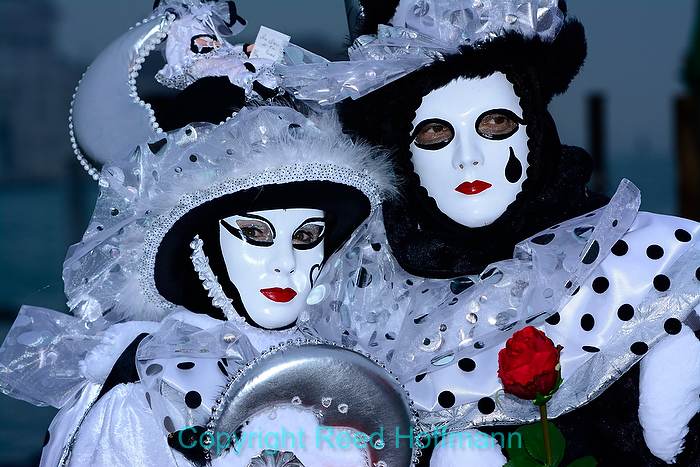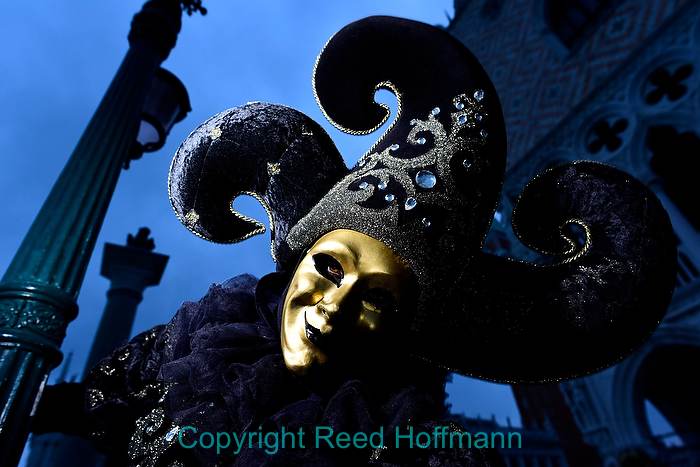As I watched – and ground my teeth – I realized it was simply a matter of ignorance. They just didn’t know any better. Here we were at an incredible photo op, and people were using direct flash!
Don’t get me wrong. I’m a big fan of flash. Used properly, it lets you create pictures that wouldn’t otherwise exist. We can put light exactly where we need it, when we want it there. That, of course, makes it a powerful photographic tool. So it drives me nuts to see people using flash poorly, which is what I saw a lot of in Venice, Italy recently.
I was there with a Mentor Trek group to photograph Carnevale, where people dress up in amazingly extravagant, detailed (and expensive!) costumes. Most of these folks are thrilled to have you shoot their picture, which of course makes it a great event for photographers. Sadly, while a lot of those photographers were using flash, few were using it properly. Because to use flash properly you need to start with an understanding of at least one key quality of light – direction.
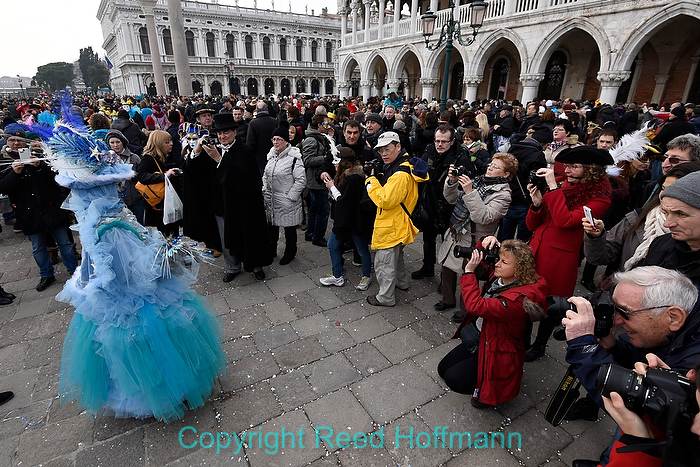
There had to be about fifty photographers for every person in costume, which added to the circus atmosphere. Nikon D750, Aperture Priority, ISO 160, 1/320 at f/5.6, EV 0.0, Nikon 16-35mm f/4 lens at 16mm. Photo copyright Reed Hoffmann.
In the old days, the rule was “put the sun over your shoulder.” That meant have the sun behind you when taking pictures, so your subjects had as much light on them as possible. Film in those days wasn’t very sensitive, so the more light, the better chance you’d have of getting a decent picture. But that also meant you’d be using “front light,” which is the least interesting because it’s flat and one-dimensional.
With two eyes, we see three-dimensionally. Almost all cameras, though, capture two-dimensionally. As photographers, then, we need to do everything we can to add that feeling of depth to our pictures. One of the easiest ways to accomplish that is with sidelight. Coming at an angle, from either side of the subject, it creates areas of light AND shadow. That combination can give the appearance of three-dimensionality (shape), as well as bring out texture. So the first rule of flash is to get it away from the camera. What we’ll refer to as “off-camera flash.” And that’s exactly what most photographers at Carnevale weren’t doing.
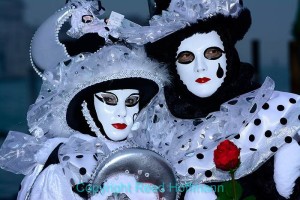
Direct flash – Yes, you get a picture, but with flat, boring light. That’s always going to be the case if you blast your subject(s) with flash from the same place the camera is. Nikon D7100, Manual exposure, ISO 200, 1/200 at f/5, Nikon 70-200mm f/2.8 lens at 120mm. Photo copyright Reed Hoffmann.
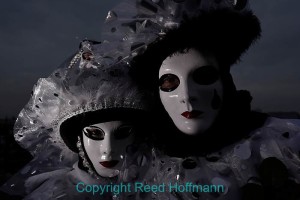
Off-camera flash – By simply moving closer, and holding the flash off to the side, I was able to create a much more interesting picture. The subjects and background are the same, all that really changed was the light. Nikon D750, Manual exposure, ISO 200, 1/400 at f/6.3, EV -1.0, Nikon 20mm f/1.8 lens. Photo copyright Reed Hoffmann.
I was blessed with great teachers at my first newspaper in Evansville, IN. Those photographers had years of experience, and understood the importance of light. So the rule was to only use flash as a last, desperate measure. That forced you to think about the available light, and how best to use it (which often meant changing your position). At my next paper, in Rochester, NY, we had cold weather for about half the year, which meant we shot indoors a lot. There I learned to use flash as a substitute for natural light. Not just putting a flash on the camera and shooting, but getting that strobe (or strobes) away from the camera (usually on stands). Something magical happens when you do that – you create light, which means you can create photos that otherwise wouldn’t exist. And that’s way cool. So back to Venice…
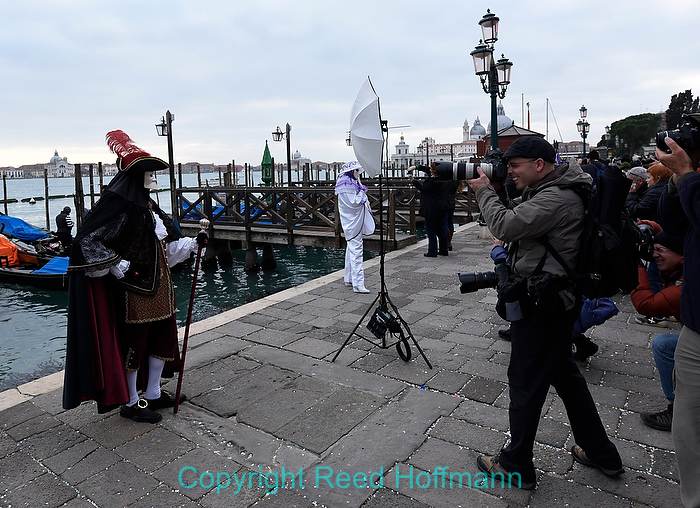
Finally, someone using flash the right way. Off-camera, and changing the SIZE of the light source using an umbrella. Nikon D750, Aperture Priority, ISO 200, 1/200 at f/5, EV 0.0, lens at 19mm. Photo copyright Reed Hoffmann.
Most of the time there it was overcast. Which brings me to another key quality of light – size. The larger the light source, the softer the light. On an overcast day, you have very soft light because the entire sky is your light source. Soft light is good for photographing people, but it lacks the contrast, shadows and drama that hard light gives. If the sun’s out, you have a hard light source, because it’s small in relation to your subject (like a spotlight). Hard light also brings out color better, so you get more saturation. As a photographer, when possible, you want to be able to control the SIZE of your light source. That’s why you see portrait photographers using umbrellas and softboxes – those tools take a small light source (the flash) and turn it into a large one. Unfortunately, most people think that anything placed in front of the flash will soften the light. And that’s simply untrue. If you think about it, you’ll realize that unless you significantly change the SIZE of the source, you won’t make the light any softer. Which is what umbrellas and soft boxes do. But a small diffusion dome on the front of a flash has little impact on its size, and so little effect on the quality of the light.
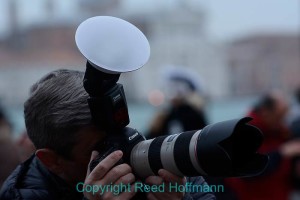
In this case, the panel in front of the flash makes it slightly bigger, but not enough to make a noticeable difference. And being pointed up at a 45-degree angle doesn’t accomplish anything helpful either. Photo copyright Reed Hoffmann.
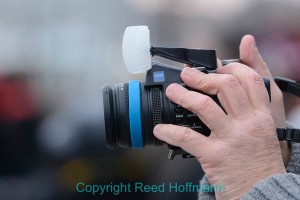
These things make me think I’m in the wrong business. Really, adding a small diffusion dome in front of a small flash makes it a TINY bit bigger. Which means no real difference in the quality of the light. Photo copyright Reed Hoffmann.
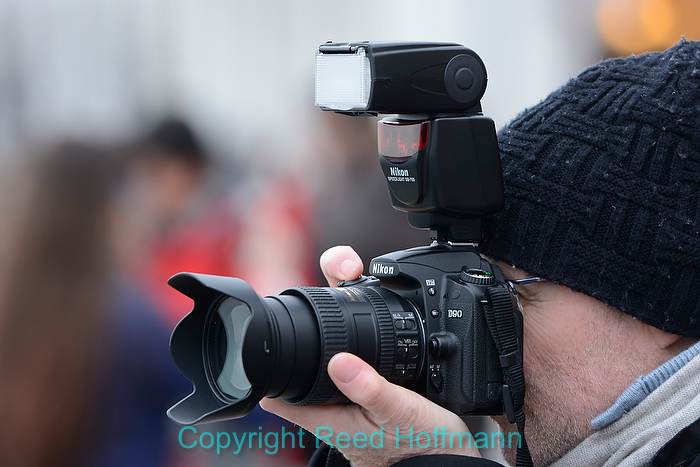
Same thing here. That diffusion panel built into the flash simply spreads the light wider, to be used with extra-wide lenses. It doesn’t change the size of the light, so it doesn’t change the quality of the light either. Photo copyright Reed Hoffmann.
So let’s do a quick review. By now you understand that getting the flash away from the camera is important. Doing that creates shadow and drama. And making the light source larger makes it softer, which can create more flattering light, especially for photographing people. In a perfect world, when shooting people you’d use a large light source at an angle (45-degrees?) to the subject. Once again, let’s go back to Venice…
Most photographers there had either an accessory flash or a camera with a pop-up flash. And sadly, many of them were using those. I say “sadly” because I know that most of them were just blasting light right into their subjects. No off-camera, no larger light source, no trying to work with the available light. Just direct, harsh flash. If there had been sun, I’d have hoped they at least knew how to reduce the power of their flash to create “fill flash,” to soften harsh shadows from the sun. But there was no sun. No, this was just direct flash, with no redeeming value. Sadly, it didn’t have to be that way.
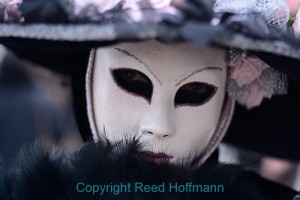
Flash wouldn’t have improved this photo in any way, and in fact, would have hurt it. The natural light, overcast and soft, filling in areas that would have been in deep shadow in sunshine, was perfect as is. Nikon D7100, Aperture Priority, ISO 320, 1/125 at f/1.8, EV -0.7, Nikon 50mm f/1.8 lens. Photo copyright Reed Hoffmann.
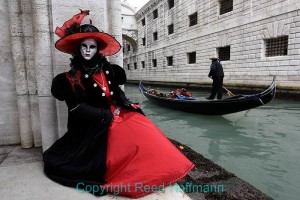
In portrait photography, I always preach the importance of backgrounds. When I saw this woman posing near the canal, I knew I just needed to wait for a gondola to come by. And again, flash wouldn’t have improved this in any way. Nikon D750, Aperture Priority, ISO 400, 1/100 at f/5.6, EV -1.0, Nikon 16-35mm f/4 lens at 24mm. Photo copyright Reed Hoffmann.
As a photographer you have to learn to work with light. You can either use what’s there – the available light – or add light of your own. But either way you need to think about it and play to its strengths. If I didn’t have a flash, or was unable to get it off camera, I’d have looked for those places (and they existed) where the available light created an interesting look. And I did that. But I also had a small flash with me (Nikon SB-500, a new, very compact flash). And both of my cameras (Nikon D7100 and D750) have something called “Commander Mode” built into them, where the pop-up flash can control most Nikon Speedlights off-camera.
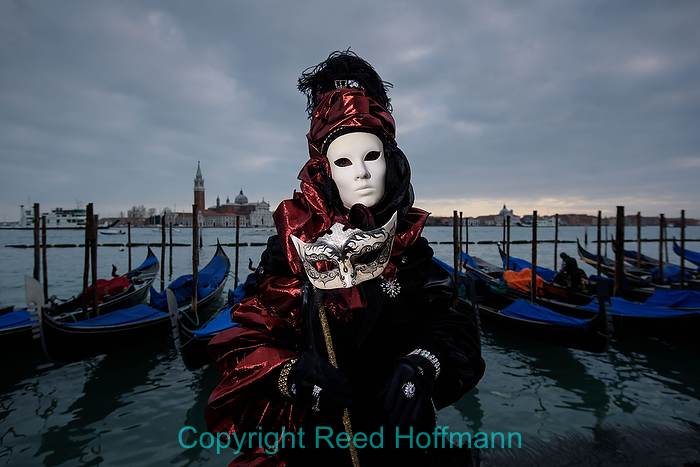
This was one of my favorite shots from Venice, and easy to make. I simply set the exposure manually to get the background the way I wanted it to look (a bit dark), then just added light to my subject. Holding that little SB-500 in my hand off to the left gave me sidelight and made the picture. Notice how the flash lights up the left side of her costume, but coming from the side creates shadows in the folds and leaves the right side dark. Nikon D750, Manual exposure, ISO 160, 1/400 at f/5.6, Nikon 16-35mm f/4 lens at 22mm. Photo copyright Reed Hoffmann.
With that capability, I was able to move close to some of those costumed people with a wide-angle lens, and by holding the flash out to the side with just my hand, create side light. Remember, the closer you get, the more angle you’ll get just by stretching out your arm. The further you are from the subject, the less the angle and the more it will just look like direct flash. That little flash also comes with a “foot,” so I could set it on the ground near my subjects, another way to create sidelight. Using those two techniques – close with the flash in my hand, and further away with the flash on the ground – allowed me to make better, more dramatic pictures.
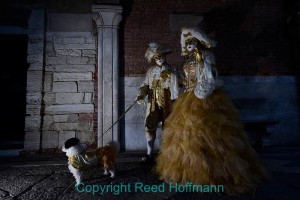
For this photo I simply put the flash on the ground to the far left, and let the camera’s built-in flash trigger it using Commander Mode. Nikon D750, Manual exposure, ISO 320, 1/25 at f/5, Nikon 20mm f/1.8 lens. Photo copyright Reed Hoffmann.
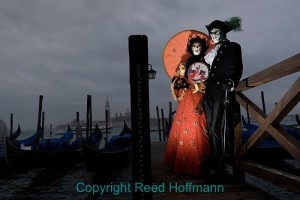
Same idea here, but I set the flash behind the post in the center of the frame, so it’s actually in the picture, but hidden.
Nikon D750, Manual exposure, ISO 125, 1/100 at f/5.6, Nikon 16-35mm f/4 lens at 25mm. Photo copyright Reed Hoffmann.
Because of the crowds, I didn’t bother bringing an umbrella or soft box. With some assistance, and a lot of patience, those could have paid off with some nice photos too. But again, you have to decide whether what you’re planning to do is worth the trouble and energy. If I return to Carnevale again, I probably will. When you have the opportunity to shoot the same event more than once, you always have to ask, “what can I do differently this time.” For me, that would be using an umbrella and/or soft box.
Flash isn’t an easy tool to learn to use properly. Our group had a few sessions where we worked with it, from that first afternoon in Croatia to our last morning in Venice. Trying to wrap your head around direction and size are challenging enough without getting into Manual exposure, white balance, Commander Mode and other controls. But you have to start somewhere, and the first step is understanding the importance of getting the flash away from the camera.
Taking it one step at a time, photography is a hobby you can continue to learn and grow with your entire life. That’s one reason it’s so much fun – you have the opportunity to continually improve. So get out there, get that flash away from the camera, and see what happens!

